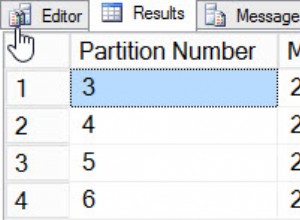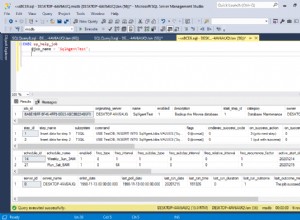Puede hacerlo en una sola llamada de php a mysql si usa un procedimiento almacenado:
Ejemplos de llamadas
mysql> call category_hier(1);
+--------+---------------+---------------+----------------------+-------+
| cat_id | category_name | parent_cat_id | parent_category_name | depth |
+--------+---------------+---------------+----------------------+-------+
| 1 | Location | NULL | NULL | 0 |
| 3 | USA | 1 | Location | 1 |
| 4 | Illinois | 3 | USA | 2 |
| 5 | Chicago | 3 | USA | 2 |
+--------+---------------+---------------+----------------------+-------+
4 rows in set (0.00 sec)
$sql = sprintf("call category_hier(%d)", $id);
Espero que esto ayude :)
Guión completo
Estructura de la tabla de prueba:
drop table if exists categories;
create table categories
(
cat_id smallint unsigned not null auto_increment primary key,
name varchar(255) not null,
parent_cat_id smallint unsigned null,
key (parent_cat_id)
)
engine = innodb;
Datos de prueba:
insert into categories (name, parent_cat_id) values
('Location',null),
('USA',1),
('Illinois',2),
('Chicago',2),
('Color',null),
('Black',3),
('Red',3);
Procedimiento:
drop procedure if exists category_hier;
delimiter #
create procedure category_hier
(
in p_cat_id smallint unsigned
)
begin
declare v_done tinyint unsigned default 0;
declare v_depth smallint unsigned default 0;
create temporary table hier(
parent_cat_id smallint unsigned,
cat_id smallint unsigned,
depth smallint unsigned default 0
)engine = memory;
insert into hier select parent_cat_id, cat_id, v_depth from categories where cat_id = p_cat_id;
/* http://dev.mysql.com/doc/refman/5.0/en/temporary-table-problems.html */
create temporary table tmp engine=memory select * from hier;
while not v_done do
if exists( select 1 from categories p inner join hier on p.parent_cat_id = hier.cat_id and hier.depth = v_depth) then
insert into hier
select p.parent_cat_id, p.cat_id, v_depth + 1 from categories p
inner join tmp on p.parent_cat_id = tmp.cat_id and tmp.depth = v_depth;
set v_depth = v_depth + 1;
truncate table tmp;
insert into tmp select * from hier where depth = v_depth;
else
set v_done = 1;
end if;
end while;
select
p.cat_id,
p.name as category_name,
b.cat_id as parent_cat_id,
b.name as parent_category_name,
hier.depth
from
hier
inner join categories p on hier.cat_id = p.cat_id
left outer join categories b on hier.parent_cat_id = b.cat_id
order by
hier.depth, hier.cat_id;
drop temporary table if exists hier;
drop temporary table if exists tmp;
end #
Ejecuciones de prueba:
delimiter ;
call category_hier(1);
call category_hier(2);
Algunas pruebas de rendimiento con datos de lugares de geoplanetas de Yahoo
drop table if exists geoplanet_places;
create table geoplanet_places
(
woe_id int unsigned not null,
iso_code varchar(3) not null,
name varchar(255) not null,
lang varchar(8) not null,
place_type varchar(32) not null,
parent_woe_id int unsigned not null,
primary key (woe_id),
key (parent_woe_id)
)
engine=innodb;
mysql> select count(*) from geoplanet_places;
+----------+
| count(*) |
+----------+
| 5653967 |
+----------+
por lo que son 5,6 millones de filas (lugares) en la tabla, veamos cómo la implementación de la lista de adyacencia/procedimiento almacenado llamado desde php maneja eso.
1 records fetched with max depth 0 in 0.001921 secs
250 records fetched with max depth 1 in 0.004883 secs
515 records fetched with max depth 1 in 0.006552 secs
822 records fetched with max depth 1 in 0.009568 secs
918 records fetched with max depth 1 in 0.009689 secs
1346 records fetched with max depth 1 in 0.040453 secs
5901 records fetched with max depth 2 in 0.219246 secs
6817 records fetched with max depth 1 in 0.152841 secs
8621 records fetched with max depth 3 in 0.096665 secs
18098 records fetched with max depth 3 in 0.580223 secs
238007 records fetched with max depth 4 in 2.003213 secs
En general, estoy bastante satisfecho con esos tiempos de ejecución fríos, ya que ni siquiera comenzaría a considerar devolver decenas de miles de filas de datos a mi interfaz, sino que preferiría construir el árbol dinámicamente obteniendo solo varios niveles por llamada. Ah, y en caso de que pensaras que innodb es más lento que myisam:la implementación de myisam que probé fue el doble de lenta en todos los aspectos.
Más cosas aquí:http://pastie.org/1672733
Espero que esto ayude :)




